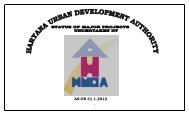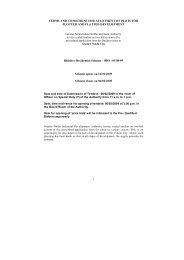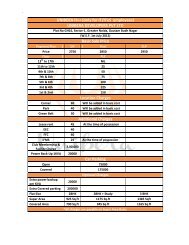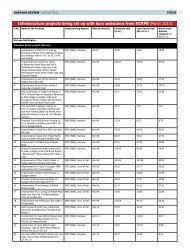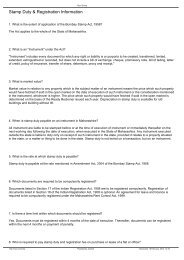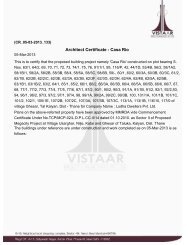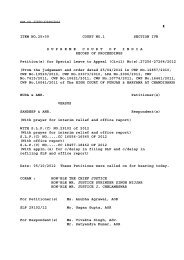eLegalix - Allahabad High Court Judgment Information System ...
eLegalix - Allahabad High Court Judgment Information System ...
eLegalix - Allahabad High Court Judgment Information System ...
You also want an ePaper? Increase the reach of your titles
YUMPU automatically turns print PDFs into web optimized ePapers that Google loves.
JUDGMENT/ORDER IN - WRIT - C No. 37443 of 2011 at <strong>Allahabad</strong> Dated-21.10....http://elegalix.allahabadhighcourt.in/elegalix/WebShow<strong>Judgment</strong>.doPage 140 of 19710/21/2011planned development of Delhi. In Pista Devi case [ 1986 (4) SCC 251 ] this <strong>Court</strong> while considering the legality ofthe exercise of the power under Section 17(4) exercised by the State Government dispensing with the inquiryunder Section 5-A for acquiring housing accommodation for planned development of Meerut, had held thatproviding housing accommodation is national urgency of which court should take judicial notice. The prenotificationand post- notification delay caused by the officer concerned does not create a cause to hold that thereis no urgency. Housing conditions of Dalits all over the country continue to be miserable even till date and is a factof which courts are bound to take judicial notice. The ratio of Deepak Pahwa case [1984 (4) SCC 308 : 1985 (1)SCR 588] was followed. In the at case a three- Judge Bench of this <strong>Court</strong> had upheld the notification issued underSection 17(4), even though lapse of time of 8 years had occurred due to inter- departmental discussions beforereceiving the notification. That itself was considered to be a ground to invoke urgency clause. It was further heldthat delay on the part of the lethargic officials to take further action in the matter of acquisition was not sufficient tonullify the urgency which existed at the time of the issuance of the notification and to hold that there was neverany urgency. In Jage Ram v. State of Haryana [1971 (1) SCC 671] this <strong>Court</strong> upheld the exercise of the power ofurgency under Section 17(4) and had held that the lethargy on the part of the officers at an early stage was notrelevant to decide whether on the day of the notification there was urgency or not. Conclusion of the Governmentthat there was urgency, though not conclusive, is entitled to create weight. In Deepak Pahwa case [1984 (4) SCC308 : 1985 (1) SCR 588] this <strong>Court</strong> held that very often person interested in the land proposed to be acquired maymake representations to the authorities concerned against the proposed writ petition that is bound to result inmultiplicity of enquiries, communications and discussions leading invariably to delay in the execution of evenurgent projects. Very often delay makes the problem more and more acute and increases urgency of thenecessity for acquisition. In Rajasthan Housing Board v. Shri Kishan [ 1993 (2) SCC 84 ] (SCC at p. 91), this<strong>Court</strong> had held that it must be remembered that the satisfaction under Section 17(4) is a subjective one and thatso long as there is material upon which Government could have formed the said satisfaction fairly, the <strong>Court</strong>would not interfere nor would it examine the material as an appellate authority. In State of U.P. v. Keshav PrasadSingh [ 1995 (5) SCC 587 ] (SCC at p. 590), this <strong>Court</strong> had held that the Government was entitled to exercise thepower under section 17(4) invoking urgency clause and to dispense with inquiry under Section 5-A when theurgency was noticed on the facts available on record. In Narayan Govind Gavate case a three-Judge Bench ofthis <strong>Court</strong> had held that Section 17(4) cannot be read in isolation from Section 4(1) and Section 5-A of the Act.Although 30 days from the notification under Section 4(1) are given for filing objections under Section 5-A, inquirythereunder unduly gets prolonged. It is difficult to see why the summary inquiry could not be completed quiteexpeditiously. Nonetheless, this <strong>Court</strong> held the existence of prima facie public purpose such as the one present inthose cases before the <strong>Court</strong> could not be successfully challenged at all by the objectors. It further held that it wasopen to the authority to take summary inquiry under Section 5-A and to complete inquiry very expeditiously. It wasemphasised that : (SCC p. 148, para 38)"... The mind of the officer or authority concerned has to be applied to the question whether there is an urgency ofsuch a nature that even the summary proceedings under Section 5-A of the Act should be eliminated. It is not justthe existence of an urgency but the need to dispense with an inquiry under Section 5-A which has to beconsidered."Another three Judge Bench judgment in the case of Meerut Development Authority and others vs. Satbir Singhand others reported in (1996)11 S.C.C. 462 considered the question of invocation of urgency clause in landacquisition for housing development. In paragraph 19 of the said judgment, relying on the Constitution Benchjudgment in the case of Aflatoon vs. Lt. Governor of Delhi reported in (1975)4 S.C.C. 285 and two Judge Benchjudgment in State of U.P. vs. Pista Devi (supra), it was observed that housing development is an urgent purposeand invocation of Section 17(1) dispensing with the inquiry is not invalid. It is relevant to note that earlier threeJudge judgment in Narain Govind Gavate's case (supra) was not noticed and reliance was placed on ConstitutionBench judgment in Aflatoon's case (supra) whereas in the Constitution Bench judgment in Aflatoon's case (supra)Section 5A of the Act was not dispensed with and objections were invited and about 6000 objections were filed.In the case of Om Prakash and another vs. State of U.P. and others reported in (1998)6 SCC 1 the Apex <strong>Court</strong>had occasion to consider invocation of urgency clause under Section 17(4) in context of acquisition of land ofvillage Chhalera Banger situate in district Ghaziabad in State of Uttar Pradesh in which notification the publicpurpose was for the planned industrial development of district Ghaziabad through New Okhla IndustrialDevelopment Authority as in the present case. The notifications were challenged in the <strong>High</strong> <strong>Court</strong> and the <strong>High</strong><strong>Court</strong> came to the conclusion that the land acquisition proceedings were not vitiated and the writ petitions weredismissed. The Apex <strong>Court</strong> looked into the all relevant materials which were before the Government including theproposal submitted by the GNOIDA for acquisition. The Apex <strong>Court</strong> also noticed one year delay from thesubmission of proposal recommending invocation of urgency clause and further delay of 9 months in issuingdeclaration under Section 6. The Apex <strong>Court</strong> observed that above conduct of the respondents falsify their claim ofurgency for acquisition. After considering the materials, which were before the State Government, the Apex <strong>Court</strong>



